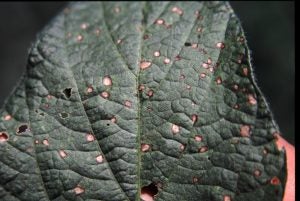Soybean prices are motivating farmers to more actively manage their soybeans. The trend for soybeans has been to plant earlier and earlier, but the cool, wet spring of 2022 meant soybeans went in later than many farmers had planned. Despite the slower-than-hoped start, soybeans are outperforming expectations.
“Timely August rains for many areas of the Corn Belt are building yields,” observes AgriGold Agronomist Brett Leahr. “And with prices where they are, there’s increased attention on what it takes to bring in a big bean crop.”
»Related: American Soybean Assoc. kicks off #SoilSeptember campaign
Focus on soil conditions rather than the calendar
“Early planting is going to be a huge factor going forward,” Leahr predicts. “If we can stretch our maturities out to the fullest, we’ll help maximize soybean yields.”
Early planting wasn’t an option for many producers this year, but when farmers were able to get in the field, soil conditions were ideal. “Soybeans emerged in five days thanks to good soil temperatures,” Leahr says. “We can get so wrapped up in the calendar, but we have to consider the environment, too.”
This season also featured “enough stress to agitate soybeans,” followed by timely August rains, according to Leahr. He says a perfect end to the season might entail a few more rains in early September followed by dry weather into harvest.

Assess soil profiles
Farmers tend to focus on potassium levels for soybeans, but Leahr says those looking to build yield should also pay attention to phosphorus. “Phosphorus is a bigger component than people credit,” he says.
Another major player is sulfur. “I can’t preach that enough,” Leahr says, pointing out soybeans use more sulfur per bushel than corn. Farmers might consider using an elemental sulfur in the fall, supplementing ATS (ammonium thiosulfate) in the spring with the planter, even y-dropping sulfur on 30-inch rows, or applying a strategic AMS top-dress application in-season.
He says 30-inch rows “open the door to y-dropping a bit of nitrogen. Some progressive farmers have started to dabble with a little bit of 28 percent liquid nitrogen preplant and some ATS as well,” he adds.
Fungicides were a good investment for soybeans this season, Leahr says, noting farmers are managing soybeans more actively than in the past and using tools like foliar feeds and seed treatments. Disease continues to be a primary yield robber in soybeans across the U.S. soybean belt – from frogeye and target spot to white mold and sudden death syndrome. Leahr says many active ingredients (and application timings) and products on the market have changed in recent years, lending to increased efficacy in controlling disease.
He also encourages farmers to examine their soils’ base saturation percentages, figures that impact soybeans’ ability to take up nutrients. “Make sure your calcium, magnesium and potassium are balanced — ideally at 80 percent calcium, 15 percent magnesium and 5 percent potassium,” he advises.

Protect the soybean plant
“Farmers also have to protect the solar panel-like leaves from diseases and insects,” Leahr says, noting that around 60 percent of yield is built by the leaves in the middle of the plant.
Waterhemp is once again a late-season threat to soybeans. “It’s such a resilient weed and the late-August rains increase the likelihood it will push through the canopy,” he says. “Planting beans early into a wider row will help close that canopy faster and limit weed germination.”
Overlapping residuals is also critical for weed control, with Leahr adding that farmers should rotate modes of action. Cover crops are another weed suppression tool he expects to become a bigger player in the future. “Rye is great at suppressing weeds, but termination timing is key,” he says.

Structure differences evident between soybean plant architecture
“I think the biggest difference I’m seeing right now between various soybean varieties is with the diversity plant structure,” Leahr observes. “Some soybeans in our lineup are a narrower soybean plant that loads the pods on the main stem. Other beans bush out more and will put more pods on the outer branches rather than loading them up on the main stem.”
Choosing the right varieties for your farm, management practices, and planting densities will help ensure success.
For a helping hand on your quest for a big soybean crop, reach out to your local AgriGold agronomist.


